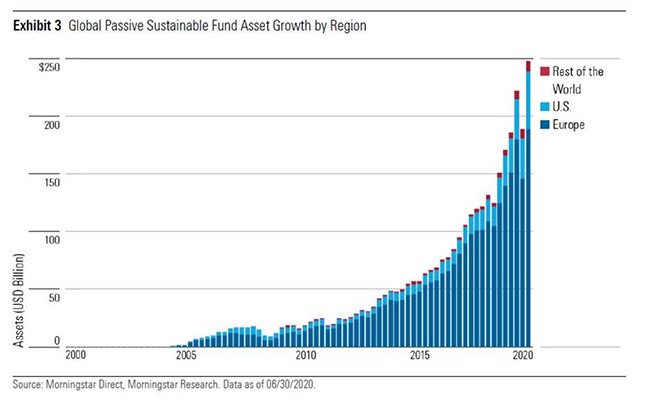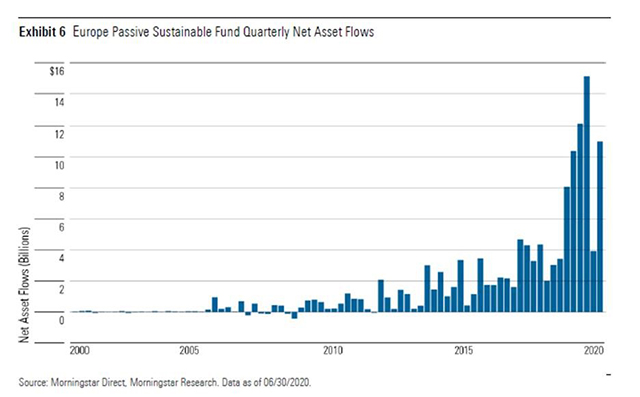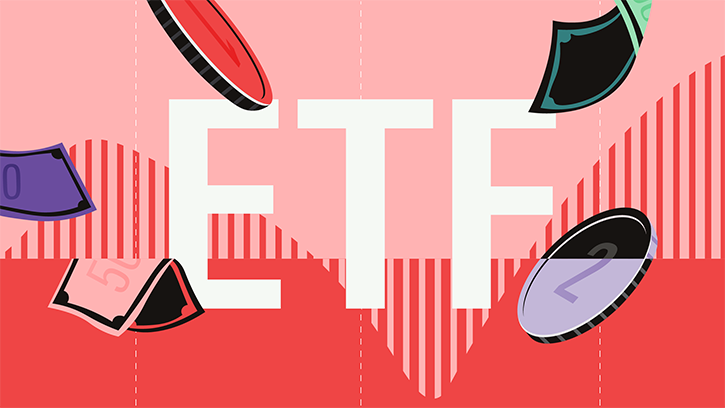
Investors have continued to pour money into tracker funds this year, even through the painful Covid-19 sell-off that defined the early part of 2020. Surprisingly, ESG-focused trackers have proven some of the most popular funds, delivering strong performance at a time when economic, social and governance factors have never been more firmly in the spotlight.
But what’s driving the popularity of sustainable passive funds and will the trend continue? Morningstar analysts have taken a deep dive into ESG tracker funds to find out how they stack up.
A Look at Sustainable ETFs
By the end of June there were 534 tracker funds with a sustainable focus, managing an incredible $250 billion of assets between them. Both the number of products and the money invested in them has doubled over the past three years alone.
European investors have been the quickest to adopt sustainable options and the region accounts for three-quarters of these assets. But for all that growth, there is a still a long way to go – both in investors’ understanding and adoption of sustainable funds.

The Popularity of ESG Funds
There are a number of factors driving the trend towards sustainable investing, says Morningstar director of manager research passive strategies Alex Bryan. Changing attitudes from investors and fund providers and greater scrutiny from consumers, regulators and employees are helping. “The Covid-19 crisis has further highlighted the importance of building sustainable resilient business models,” adds Bryan.
In January this year, BlackRock made a public commitment to sustainable investing, while the Norwegian Sovereign Wealth Fund divested away from fossil fuels, and Japan’s Government Pension Investment Fund also ramped up its ESG allocations.
Another key driver is the number of funds available to investors. Some 98 new passive ESG funds were launched in 2019 and there were 84 new launches in the first half of this year alone. The majority of these funds are equity-focused, with only around 9% of total sustainable passive assets in fixed income funds.

Around 9% of the total amount invested in passive funds across Europe is now in sustainable options, up from just 5% in 2016. And the flow of money into these funds has remained resilient, even during market turmoil.
Innovation has been key to the growth of this part of the industry, says Bryan. “In July 2020, Lyxor introduced a range of climate change ETFs that offer equity exposure with reduced carbon footprints explicitly in accordance with the Paris Climate Agreement,” he adds. These were the first funds to be awarded the Paris-Aligned designation and fund groups BNP Paribas and Franklin Templeton quickly came up with their own versions, with Franklin launching two smart beta ETFs in July.

Will the popularity of sustainable funds continue? Recent performance has likely played a role in the strong flows they have enjoyed in recent months and years. “Many of these funds underweight the energy sector and overweight technology stocks, which has helped performance,” says Bryan.
But there are other factors at work, helping to fuel adoption, too. Demographic shifts as younger generations start investing and tend more towards sustainable funds than their older counterparts, the growing urgency of climate change, and appreciation of the importance of diversity in company decision-making have all thrust ESG into the spotlight.
This year, the Covid-19 pandemic and movement for racial justice in the US have kept issues of ESG high on the agenda and particularly the often less talked about “S” in ESG.
These issues and strong performance have helped attract money to ESG options but many sustainable funds have fairly short track records. Of the 103 sustainable index funds in the US, for example, just 41 were launched prior to 2016.
Obstacles to ESG Investing
There are obstacles for sustainable funds to overcome, however, before they can truly move into the mainstream. A lack of consistent and reliable ESG data has been a “source of ongoing frustration”, says Bryan, particularly for investors who want their portfolios to represent their world views.
Another difficulty investors face is the wide range of approaches that funds take to sustainable investing, which can be tricky to understand or differentiate between.
Bryan says: “Passive approaches vary on where they draw the line on ESG performance and on how closely they structure the portfolio to a standard benchmark. Some portfolios provide broad market exposure and hold hundreds of securities, while others focus more narrowly on specific sustainable subsectors like renewable energy and can hold as few as 20 stocks.”
We’ve written previously on the main approaches that ESG funds can take including Exclusion-Only, Broad ESG and Thematic options.
A further hurdle for these funds is the perception that they are more expensive compared to their non-sustainable counterparts. But Bryan says this may be a thing of the past: “Investors in most core equity markets now no longer have to pay a sizeable premium and, in some cases, pay no premium at all when compared with their non-sustainable peers.”
He points to iShares as an example, which offers both ESG-screened and ESG-enhanced variants of core equity funds at no higher cost. Average fees tend to correspond to the intensity of the ESG exposure of a fund, he adds. Exclusion-Only funds, for example, usually have the lightest sustainability impact and charge the least, Broad ESG funds slightly more, and more focused Thematic funds charge the most.

Many investors will see sustainable funds as a direct substitute for a non-sustainable fund that might otherwise be in their portfolio. It is no wonder then that funds taking a Broad ESG approach tend to be more popular than more niche, thematic options. The latter might include funds such as the UBS Global Gender Equality ETF (GENDEE), which invests in global equities with favourable gender metrics, or the iShares Global Clean Energy ETF (INRG), which invests exclusively in companies involved in the clean energy business.










.jpg)

















